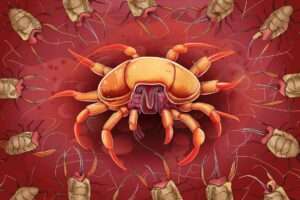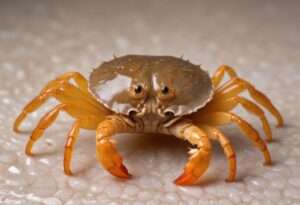Pubic Lice (Crabs): Symptoms, Diagnosis and Treatment
Have you ever heard of “crabs” and wondered what they really are? No, we’re not talking about seafood – we’re referring to pubic lice, a common but often misunderstood sexually transmitted infection (STI).
In this comprehensive guide, we’ll explore everything you need to know about pubic lice, from identifying symptoms to seeking treatment and prevention.
Anal STI Testing: A Comprehensive Guide to Protecting Your Sexual Health

Table of Contents
ToggleWhat Are Pubic Lice?
Pubic lice, scientifically known as Pthirus pubis, are tiny parasitic insects that infest the pubic hair area. These minuscule creatures, commonly called “crabs” due to their crab-like appearance, feed on human blood and can cause intense itching and discomfort.
According to the Centers for Disease Control and Prevention (CDC), an estimated 3- million cases of pubic lice infestation occur each year in the United States alone. Despite this prevalence, many people are unaware of the signs and symptoms of pubic lice infestation.
The State of Sex Education in America: Challenges and Progress

How Do You Get Pubic Lice?
Contrary to popular belief, pubic lice are not necessarily a sign of poor hygiene. These parasites spread primarily through:
1. Sexual contact: This is the most common method of transmission.
2. Close physical contact: Sharing a bed or clothing with an infected person can lead to infestation.
3. Sharing personal items: Using towels, bedding, or clothing of an infected person can transfer the lice.
It’s important to note that pubic lice cannot jump or fly, and they do not spread through toilet seats or swimming pools.
Understanding STD Incubation Periods: A Comprehensive Guide

Identifying Pubic Lice: Signs and Symptoms
Recognizing the signs of pubic lice infestation is crucial for early detection and treatment. Here are the key symptoms to watch out for:
1. Intense itching: This is often the first and most noticeable symptom, typically occurring in the pubic area.
The Ultimate Guide to Condom Use: 15 Compelling Reasons to Wrap It Up
2. Visible lice or eggs: You may spot tiny, grayish-white eggs (nits) attached to pubic hair, or see the lice themselves, which appear as small, crab-like insects.
3. Dark or bluish spots: These marks on the skin are caused by lice bites and may persist for several days.
4. Visible blood spots: You might notice small specks of blood on your underwear, caused by the lice feeding.
5. Irritation and inflammation: The affected area may become red, inflamed, or develop a rash due to scratching.
6. Presence in other body areas: While pubic lice primarily infest the pubic region, they can also be found in other coarse body hair, such as:
– Chest hair
– Armpit hair
– Facial hair (including eyebrows and eyelashes)
– Leg hair
It’s worth noting that symptoms may not appear immediately after infestation. It can take several weeks for signs to develop, which is why regular self-examinations are important, especially if you suspect exposure.

Diagnosing Pubic Lice
If you suspect you have pubic lice, it’s essential to seek medical attention for proper diagnosis and treatment. Here’s what you can expect during the diagnostic process:
1. Visual examination: A healthcare provider will examine the affected area using a magnifying glass to spot lice or nits.
2. Dermatoscopy: This non-invasive technique uses a special microscope to examine the skin and hair follicles more closely.
3. Microscopic analysis: In some cases, a sample of hair or skin may be examined under a microscope to confirm the presence of lice or eggs.
Treatment Options for Pubic Lice
Once diagnosed, several treatment options are available to eliminate pubic lice:
1. Over-the-counter treatments:
– Permethrin 1% cream
– Pyrethrin-based shampoos
2. Prescription medications:
– Malathion 0.5% lotion
– Ivermectin (oral medication)
3. Manual removal: Using a fine-toothed comb to remove lice and nits can be effective when combined with other treatments.
It’s crucial to follow the treatment instructions carefully and repeat the application as directed, usually after 9-10 days, to ensure all newly hatched lice are eliminated.
Preventing Pubic Lice Reinfestation
To avoid reinfestation after treatment:
1. Wash all bedding, towels, and clothing used in the past 2-3 days in hot water (at least 130°F) and dry on high heat.
2. Items that can’t be washed should be sealed in a plastic bag for at least two weeks.
3. Vacuum the area where the infested person sat or lay.
4. Avoid sexual contact until treatment is complete and no lice or nits are visible.
5. Inform recent sexual partners so they can be treated if necessary.
Pubic Lice vs. Other Conditions
It’s important to distinguish pubic lice from other conditions that may cause similar symptoms:
1. Scabies: Another parasitic skin infestation that causes intense itching but affects different areas of the body.
2. Folliculitis: Inflammation of hair follicles that can cause itching and redness.
3. Allergic reactions: Certain products or fabrics may cause itching and irritation in the pubic area.
4. Other STIs: Some sexually transmitted infections can cause itching or discomfort in the genital area.
When to Seek Medical Help?
While pubic lice are generally not dangerous, you should consult a healthcare provider if:
– You’re unsure if you have pubic lice
– Over-the-counter treatments haven’t been effective
– You’re pregnant or breastfeeding
– You develop signs of a secondary skin infection, such as pus or severe redness
Conclusion
Pubic lice, while uncomfortable and potentially embarrassing, are a common and treatable condition. By understanding the signs and symptoms, seeking prompt treatment, and taking preventive measures, you can effectively manage and prevent pubic lice infestations.
Remember, open communication with sexual partners and regular self-examinations are key to maintaining your sexual health.
Reference to External Sources:
[1] https://www.cdc.gov/parasites/lice/pubic/index.html
[2] https://www.who.int/news-room/fact-sheets/detail/scabies
[3] https://www.ncbi.nlm.nih.gov/books/NBK544296/
[4] https://www.aafp.org/pubs/afp/issues/2019/1015/p496.html


